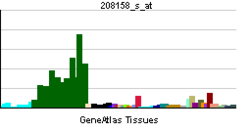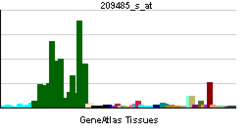- OSBPL1A
-
Oxysterol binding protein-like 1A Identifiers Symbols OSBPL1A; FLJ10217; ORP-1; ORP1; OSBPL1B External IDs OMIM: 606730 MGI: 1927551 HomoloGene: 84746 GeneCards: OSBPL1A Gene Gene Ontology Molecular function • phospholipid binding Cellular component • intracellular Biological process • lipid transport
• cholesterol metabolic process
• vesicle-mediated transportSources: Amigo / QuickGO RNA expression pattern 

More reference expression data Orthologs Species Human Mouse Entrez 114876 64291 Ensembl ENSG00000141447 ENSMUSG00000044252 UniProt Q9BXW6 Q8K2D2 RefSeq (mRNA) NM_001242508.1 NM_207530.2 RefSeq (protein) NP_001229437.1 NP_997413.2 Location (UCSC) Chr 18:
21.74 – 21.98 MbChr 18:
12.91 – 13.1 MbPubMed search [1] [2] Oxysterol-binding protein-related protein 1 is a protein that in humans is encoded by the OSBPL1A gene.[1][2][3]
This gene encodes a member of the oxysterol-binding protein (OSBP) family, a group of intracellular lipid receptors. Most members contain an N-terminal pleckstrin homology domain and a highly conserved C-terminal OSBP-like sterol-binding domain, although some members contain only the sterol-binding domain. Transcript variants derived from alternative promoter usage and/or alternative splicing exist; they encode different isoforms.[3]
References
- ^ Xu Y, Liu Y, Ridgway ND, McMaster CR (May 2001). "Novel members of the human oxysterol-binding protein family bind phospholipids and regulate vesicle transport". J Biol Chem 276 (21): 18407–14. doi:10.1074/jbc.M101204200. PMID 11279184.
- ^ Laitinen S, Olkkonen VM, Ehnholm C, Ikonen E (Feb 2000). "Family of human oxysterol binding protein (OSBP) homologues. A novel member implicated in brain sterol metabolism". J Lipid Res 40 (12): 2204–11. PMID 10588946.
- ^ a b "Entrez Gene: OSBPL1A oxysterol binding protein-like 1A". http://www.ncbi.nlm.nih.gov/sites/entrez?Db=gene&Cmd=ShowDetailView&TermToSearch=114876.
Further reading
- Lehto M, Laitinen S, Chinetti G, et al. (2001). "The OSBP-related protein family in humans.". J. Lipid Res. 42 (8): 1203–13. PMID 11483621.
- Jaworski CJ, Moreira E, Li A, et al. (2002). "A family of 12 human genes containing oxysterol-binding domains.". Genomics 78 (3): 185–96. doi:10.1006/geno.2001.6663. PMID 11735225.
- Strausberg RL, Feingold EA, Grouse LH, et al. (2003). "Generation and initial analysis of more than 15,000 full-length human and mouse cDNA sequences.". Proc. Natl. Acad. Sci. U.S.A. 99 (26): 16899–903. doi:10.1073/pnas.242603899. PMC 139241. PMID 12477932. http://www.pubmedcentral.nih.gov/articlerender.fcgi?tool=pmcentrez&artid=139241.
- Johansson M, Bocher V, Lehto M, et al. (2004). "The two variants of oxysterol binding protein-related protein-1 display different tissue expression patterns, have different intracellular localization, and are functionally distinct.". Mol. Biol. Cell 14 (3): 903–15. doi:10.1091/mbc.E02-08-0459. PMC 151568. PMID 12631712. http://www.pubmedcentral.nih.gov/articlerender.fcgi?tool=pmcentrez&artid=151568.
- Ota T, Suzuki Y, Nishikawa T, et al. (2004). "Complete sequencing and characterization of 21,243 full-length human cDNAs.". Nat. Genet. 36 (1): 40–5. doi:10.1038/ng1285. PMID 14702039.
- Johansson M, Lehto M, Tanhuanpää K, et al. (2006). "The oxysterol-binding protein homologue ORP1L interacts with Rab7 and alters functional properties of late endocytic compartments.". Mol. Biol. Cell 16 (12): 5480–92. doi:10.1091/mbc.E05-03-0189. PMC 1289395. PMID 16176980. http://www.pubmedcentral.nih.gov/articlerender.fcgi?tool=pmcentrez&artid=1289395.
- Olsen JV, Blagoev B, Gnad F, et al. (2006). "Global, in vivo, and site-specific phosphorylation dynamics in signaling networks.". Cell 127 (3): 635–48. doi:10.1016/j.cell.2006.09.026. PMID 17081983.
Categories:- Human proteins
- Chromosome 18 gene stubs
Wikimedia Foundation. 2010.
